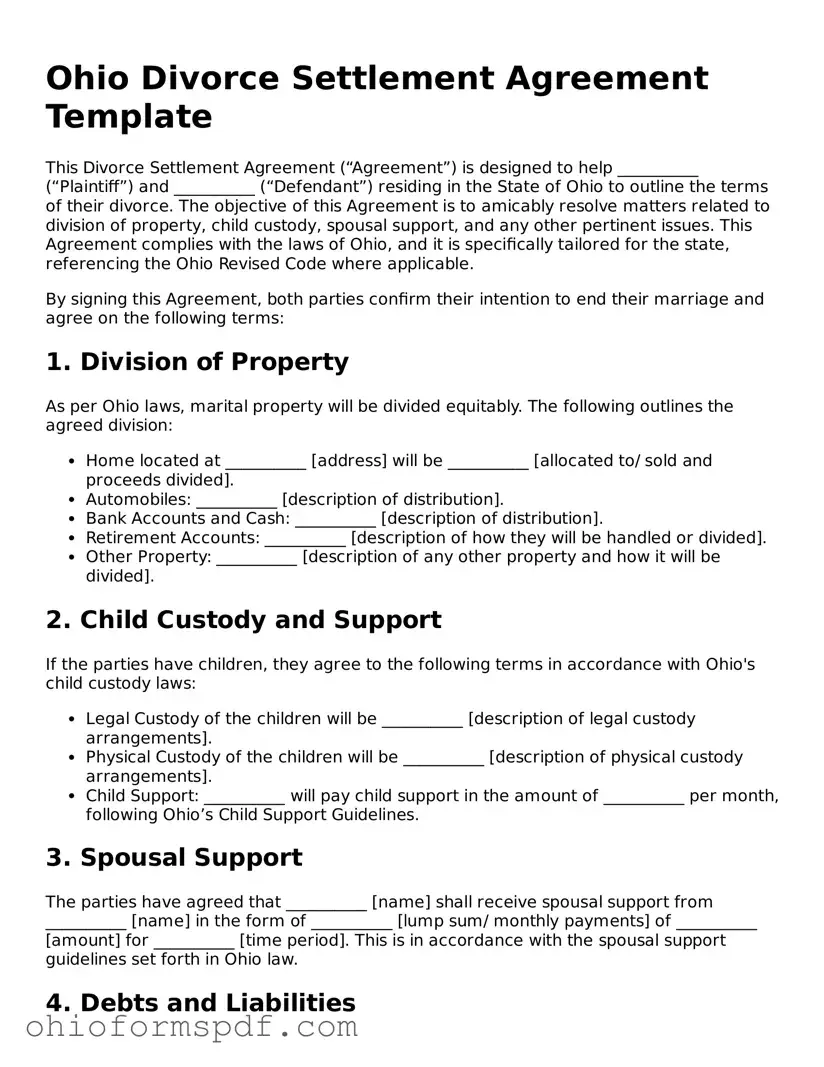What is an Ohio Divorce Settlement Agreement?
An Ohio Divorce Settlement Agreement is a legally binding document that outlines how spouses have agreed to divide their shared assets, debts, and handle child custody, support, and alimony issues. This document is crafted to ensure that the division is fair and acceptable to both parties and meets the legal requirements of the state of Ohio.
Do both parties need to agree to the terms of the Divorce Settlement Agreement?
Yes, both parties must fully agree to the terms of the Divorce Settlement Agreement. It is essential as this agreement is meant to represent a mutual understanding and settlement of all matters related to their divorce. Once agreed upon, it must be signed by both spouses, making it enforceable by a court.
Can the Ohio Divorce Settlement Agreement be modified after it is finalized?
Once a Divorce Settlement Agreement is finalized and approved by the court, it becomes challenging to modify. Modifications to the agreement are generally only possible if both parties agree to the changes or if a significant change in circumstances occurs, compelling a review. Any modifications must also be approved by a court.
What happens if one spouse does not follow the terms of the agreement?
If one spouse fails to comply with the terms of the agreement, the other spouse may file a motion with the court to enforce the agreement. The court may then take various actions, including ordering compliance, awarding damages to the aggrieved party, or other measures to ensure the terms are met.
Is it necessary to have a lawyer to create an Ohio Divorce Settlement Agreement?
While it is not legally required to have a lawyer to create an Ohio Divorce Settlement Agreement, it is highly recommended. A lawyer can provide vital legal guidance, ensure that all necessary matters are covered, and confirm that the agreement complies with Ohio law. Legal representation can help protect your rights and interests throughout the process.
How is child custody decided in an Ohio Divorce Settlement Agreement?
In Ohio, child custody is decided based on what is in the best interests of the child(ren). Many factors are considered, including the wishes of the child(ren), the child's interaction and relationship with parents and siblings, the child's adjustment to home, school, and community, and the mental and physical health of all involved. Spouses can agree on custody terms, but the agreement must serve the child's best interests to be approved by the court.
Are assets always divided equally in an Ohio Divorce Settlement Agreement?
No, assets are not always divided equally. Ohio is an equitable distribution state, meaning that assets are divided fairly but not necessarily equally between spouses. The division is based on various factors, including the duration of the marriage, assets and liabilities of the spouses, and each spouse's earning ability. The goal is to reach a division that is fair and equitable under the circumstances.
